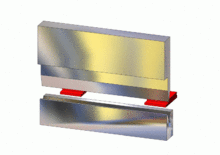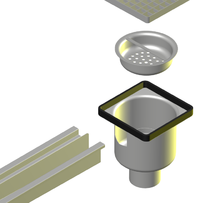sheet

A sheet is a rolling mill product consisting of metal , which is delivered as a panel and whose width and length are very much greater than its thickness. Almost any metal can be processed into sheet metal. Traditional handicraft work was the hammering of sheet metal from cast parts. Coiled sheet metal strips are often referred to as tape .
Preliminary products
The semi-finished products for sheet metal are rolled or cast slabs or blanks. For sheets made of non-ferrous metals, also bars . Thin sheets are currently mostly cut from strips. These are made from continuously cast slabs.
Types of sheet metal
Sheet metal
Thin sheets are thinner than 3 mm. It is hot or cold finish-rolled material. Depending on the type of steel , these thin sheets can also be tinned, galvanized, copper-plated, nickel-plated, painted, enamelled or plastic-coated.
Middle plate (obsolete)
Since DIN 1543 was changed in 1981 , the term middle sheet is no longer standardized. In the past, it was divided into thin, medium and heavy plates. Here were:
- Thin sheets in the thickness range: t <3.00 mm
- Middle sheets in the thickness range: 3.00 mm ≤ t ≤ 4.75 mm
- Heavy plates in the thickness range: t> 4.75 mm
Heavy plate
EN 10079 defines heavy plate as a flat product with a thickness of more than 3 mm. In contrast to hot strip , heavy plate is usually not wound into a coil . However, it is technically possible to wind it up to a thickness of about 32 mm. The slabs for heavy plate are rolled crosswise in the first few passes until they have reached the target width. Then they are turned and finish-rolled to their final thickness. They then cool down in air on a cooling bed, or are specifically cooled in a quench in order to adjust the material properties .
The maximum thickness for heavy plate is now more than 175 mm, as further developments in continuous casting allow plate thicknesses of up to 300 mm.
tape
As a band mill shall be described, which are much longer than wide and thick as well as to a covenant have been wound up. Strictly speaking, they are not sheet metal. Panels that are cut from strip are colloquially referred to as sheet metal.
Hot-rolled strips can be produced in thicknesses between 0.8 and 23 mm. Cold-rolled strips are much thinner.
Sheet formats
Blackboard , a rectangular sheet of standard dimensions
| designation | dimension | Alternative Description |
|---|---|---|
| Small format | 1000 x 2000 | Normal board |
| Medium format | 1250 × 2500 | Central panel |
| Large format | 1500 × 3000 | Large table |
| Maxi format | 2000 × 4000 | Maxi table |
The following dimensions are available from stock as standard formats in Germany:
| Width × length | Length oversized formats |
|---|---|
| 2,000 × 6,000 | 8,000 / 12,000 |
| 2,500 x 6,000 | 8,000 / 12,000 |
| 3,000 × 6,000 | 8,000 / 12,000 |
| 3,500 × 7,000 | 14,000 |
| 4,000 × 12,000 | 16,000 |
The technical possibilities of producing sheet steel nowadays end approximately at the dimensions 4,700 mm × 24,000 mm.
To further increase or develop these possibilities is currently uneconomical. Because of the piece weights, the sheet metal formats can no longer be transported economically or the large formats from one piece are not required. The largest sheet metal formats are required in bridge construction , drilling platforms and pipeline construction. An increasing demand is expected for pipelines in particular. For this purpose, new heavy plate mills are currently being built, especially in Russia and China .
Manufacturing
Traditionally, metal sheets are produced by reversing rolling. After heating, the pre-material is first pierced across and rolled to the desired width, then turned and rolled to the desired thickness. Today, heavy plates with thicknesses ≥ 5 mm and widths ≥ 2000 mm are rolled in this way.
Thin sheets are rolled in multiple layers. In other words, several sheets are placed on top of one another or folded (doubled) and rolled in a package, since the required roll gaps could not be set with the soft roll stands available. Over-hoisting mills were sometimes used for this, with the direction of rotation that cannot be changed. The rolling stock was returned over the top roll. After the last stitch, the package was separated again while still warm.
Today only thin sheets are rolled in reversing motion for special applications, e.g. B. to create a certain texture .
Today, thin sheets are usually cut from hot or cold strip . Strictly speaking, these are not sheet metal, but cut panels. Their maximum width is limited by the rolling mill.
use
A wide variety of products can be made from sheet metal. Highly productive systems often use strips as input material, which are unwound directly into the machine. After cutting to size, the parts are brought into the desired shape using various forming processes and then possibly connected .
Steel sheets are z. B. used for:
- domestic appliances
- Control cabinets
- Automobile manufacturing
- mechanical engineering
- Modelling
- welded pipes
- Rail vehicles
- Shipbuilding including offshore structures
- Steel and bridge construction
- Masts of wind turbines
- toy
- Signs
- Packaging , in particular tin cans
Machining

Processing in the flat state, in particular cutting the sheet metal to size, is carried out by flame cutting , plasma fusion cutting , laser cutting , water jet cutting , nibbling (punching), shear cutting or sawing . Other special tools are sheet metal shears and sheet metal shears .
Downstream processes are primarily deep drawing , bending , drilling , driving , hallmarking , collar drawing , roll forming or round rolling . In addition to the processing of individual sheet metal parts, the joining ( joining ) of sheet metal is also important. The following processes are used here: welding , soldering , riveting , folding , screwing , gluing and clinching .
Sheet metal can be easily deformed through mechanical processing or heat treatment , but especially during the rolling process . There are unwanted bumps. Depending on the thickness and material of the sheet metal, these unevenness can be removed using hydraulic straightening presses or roller straightening systems. This process is called straightening . Rolling mills and special service providers often use straightening systems directly after the rolling process . The flatness tolerances are described in DIN EN 10029. This differentiates between normal (class N) and restricted flatness tolerances (class S).
Sheet metal logistics

Sheet metal logistics (obsolete: sheet metal handling ) includes transport between the processing steps, intermediate storage, loading and transport to the end user. There are special requirements that result from the different sheet metal formats.
Regardless of the sheet metal format, special conveyor belts , roller tables and crane systems with special load handling devices are used in the production of sheet metal . Cross members with chain hangers, suction devices or magnets are mostly used as load handling devices. Transports are carried out with trucks , railroad cars or cargo ships .
Oversized formats require special devices and vehicles. The selection of the devices and vehicles essentially depends on the maximum weight, the maximum length or the maximum width of the metal sheets. For oversize formats, trucks with special bodies are used. For sheet metal lengths over 18.75 m, special permits are required for road transport. S-wagons for heavy loads are used for transporting large sheet metal by rail , as they are designed for high weights and excess lengths.
Special sheets
- Blue sheet - a cold-rolled sheet with a firmly adhering iron oxide layer that can serve as corrosion protection
- Checker plate
- Black sheet - untreated sheet that has not been cleaned in a scale washer and therefore still contains a superficial layer of iron oxide ( scale )
- Tinplate - usually 0.1 to 0.5 mm thick, tinned sheet metal, which is processed into beverage cans , for example
- Corrugated sheet - edged corrugated sheet metal to form sine waves or trapezoidal sheet, which has an increased load-bearing capacity in the longitudinal direction and is mostly used for constructional purposes.
See also
Web links
Individual evidence
- ↑ a b Product range Delivery program of Ilsenburger Heavy Plate . Retrieved July 1, 2018.
- ↑ a b product range delivery program of voestalpine heavy plate. Retrieved July 1, 2018.
- ↑ efficient logistics website of Salzgitter Mannesmann Stahlservice, accessed on June 28, 2018.
- ↑ maximum truck length Bußgeldkatalog.org, accessed on June 28, 2018.


